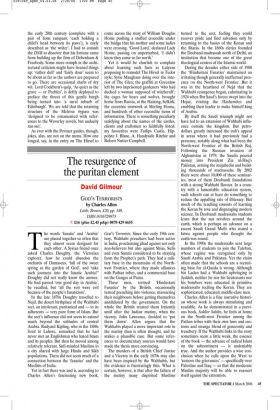The resurgence of the puritan element
David Gilmour
GOD’S TERRORISTS by Charles Allen
Little, Brown, £20, pp. 349, ISBN 0316729973
✆ £16 (plus £2.45 p&p) 0870 429 6655 The words ‘fanatic’ and ‘Arabia’ are placed together so often that they almost seem designed for each other. A Syrian friend once asked Charles Doughty, the Victorian explorer, how he could abandon the orchards of Damascus, ‘full of the sweet spring as the garden of God’, and ‘take such journeys into the fanatic Arabia?’ Doughty did not really know the answer. He had passed ‘one good day in Arabia’, he recalled, but ‘all the rest were evil because of the people’s fanaticism’.
In the late 1870s Doughty travelled to Nejd, the desert birthplace of the Wahhabi sect, an intolerant, puritanical and — to its adherents — very pure form of Islam. But the sect’s influence did not seem to extend much beyond the solitudes of central Arabia. Rudyard Kipling, who in the 1880s lived in Lahore, remarked that he had never met an Englishman who hated Islam and its peoples. But then he moved among relatively tolerant, Sufi-minded Muslims in a city shared with large Hindu and Sikh populations. There did not seem much of a connection between the ‘fanatics’ and the Muslims of India.
Yet in fact there was and is, according to Charles Allen’s fascinating new book, God’s Terrorists. Since the early 19th century, Wahhabi preachers had been active in India, proclaiming jihad against not only non-believers but also against Shias, Sufis and even Sunnis considered to be straying from the Prophet’s path. They had a military base in the mountains of the Northwest Frontier, where they made alliances with Pathan tribes, and a commercial base on the Ganges at Patna.
These men, termed ‘Hindustani Fanatics’ by the British, occasionally turned preaching into violence, massacring their neighbours before getting themselves annihilated by the government. On the whole the British treated them leniently until after the Indian mutiny, when the viceroy, John Lawrence, decided to ‘put them down’. Allen argues that the Wahhabis played a more important role in the mutiny than is often thought, and he makes a plausible case. But some references to documentary sources would have made the thesis more convincing.
The murders of a British Chief Justice and a Viceroy in the early 1870s may also have been inspired by the Wahhabis, but the evidence is frustratingly thin. What is certain, however, is that after the failure of the mutiny many dispirited Muslims turned to the sect, feeling they could recover pride and find salvation only by returning to the basics of the Koran and the Sharia. In the 1860s clerics founded the Deoband madrassah north of Delhi, an institution that became one of the great theological centres of the Islamic world.
During the decades either side of 1900 the ‘Hindustani Fanatics’ maintained an irritating though generally ineffectual presence on the North-west Frontier. But it was in the heartland of Nejd that the Wahhabi resurgence began, culminating in 1924 when Ibn Saud’s forces swept into the Hejaz, evicting the Hashemites and enabling their leader to make himself king of Arabia.
By itself the Saudi triumph might not have led to an extension of Wahhabi influence outside the kingdom. But petrodollars greatly increased the cult’s appeal in areas where it had previously had a presence, notably along what had been the North-west Frontier of the British Raj. Following the Russian invasion of Afghanistan in 1979, the Saudis poured money into President Zia ul-Haq’s Pakistan, arming the mujahedin and building thousands of madrassahs. By 2002 there were about 10,000 of these seminaries, most of them Deobandi foundations with a strong Wahhabi flavour. In a country with a lamentable education system, such schools can at least do something to reduce the appalling rate of illiteracy. But much of the teaching consists of learning the Koran by rote and disparaging modern science. In Deobandi madrassahs students learn that the sun revolves around the earth, which is perhaps an advance on a recent Saudi Grand Mufti who issued a fatwa against people who thought the earth was round.
In the 1990s the madrassahs sent large numbers of students to join the Taleban, whose regime was recognised only by Saudi Arabia and Pakistan. Yet the claim often made that the schools are a recruiting base for al-Qaeda is wrong. Although bin Laden had a Wahhabi upbringing in Jeddah, neither he nor his lieutenants nor his bombers were educated in primitive madrassahs reciting the Koran. They are sophisticated, educated, middle-class men.
Charles Allen is a fine narrative historian whose work is always stimulating and readable. As he demonstrated in a previous book, Soldier Sahibs, he feels at home on the North-west Frontier among the Pathan tribes with their own laws and customs and strange blend of generosity and treachery. If the Wahhabi links in the story sometimes seem a little weak, the essence of the book — the advance of radical Islam on the subcontinent — is undeniably true. And the author provides a wise conclusion when he calls upon the West to ‘remove the grievances’ — specifically over Palestine and Iraq — so that the moderate Muslim majority will be able to reassert itself against the extremists.










































































 Previous page
Previous page